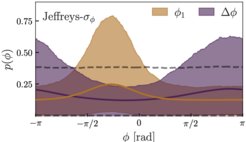Spin-orbit resonances: first hints from LIGO-Virgo
Spin measurements from binary black hole mergers observed by gravitational wave detectors like LIGO and Virgo carry valuable clues about how these binaries form in nature. Theorists have predicted that binaries could be attracted towards special configurations called spin-orbit resonances, where the spin and orbital angular momenta become locked into a resonant plane. The authors find the first potential signs of these resonances in gravitational wave data. These resonances are expected for stellar binaries that undergo asymmetric supernova explosions, imparting recoil velocities to the black holes at birth. Previous estimates suggested that observing these resonances would not be possible until next-generation detectors become active in the 2030s. However, leveraging accurate models based on supercomputer simulations, and new techniques for measuring spins, the authors demonstrate that they can extract this precious astrophysical information with current detectors. While more observations are necessary to confirm these findings, spin-orbit resonances can provide key insights into long-standing astrophysical mysteries like the supernova mechanism.
Paper abstract

Binary black hole spin measurements from gravitational wave observations can reveal the binary's evolutionary history. In particular, the spin orientations of the component BHs within the orbital plane, ϕ1 and ϕ2, can be used to identify binaries caught in the so-called spin-orbit resonances. In a companion paper, we demonstrate that ϕ1 and ϕ2 are best measured near the merger of the two black holes. In this work, we use these spin measurements to constrain the distribution of ϕ1 and Δϕ=ϕ1−ϕ2 over the astrophysical population of merging binary black holes. We find that there is a preference for Δϕ∼±π in the population, which can be a signature of spin-orbit resonances. We also find a preference for ϕ1∼−π/4 with respect to the line of separation near merger, which has not been predicted for any astrophysical formation channel. However, the strength of these preferences depend on our prior choices, and we are unable to constrain the widths of the ϕ1 and Δϕ distributions. Therefore, more observations are necessary to confirm the features we find. Finally, we derive constraints on the distribution of recoil kicks in the population, and use this to estimate the fraction of merger remnants retained by globular and nuclear star clusters.












